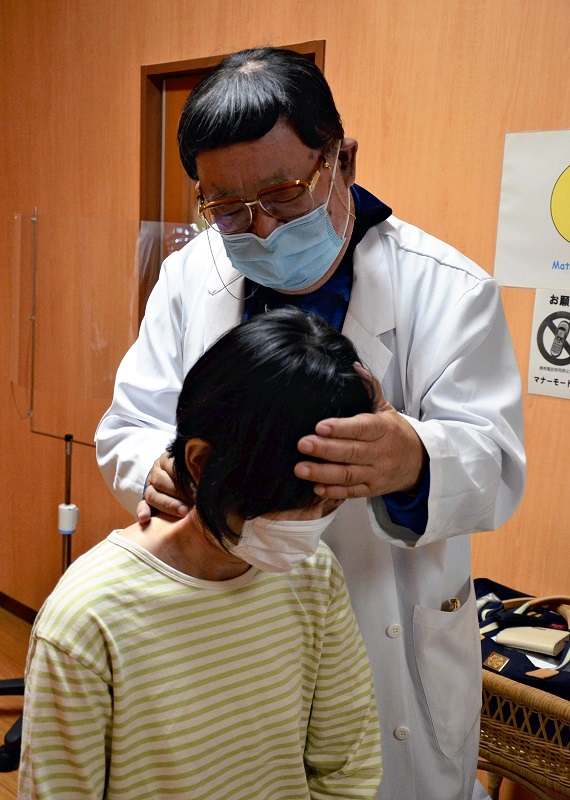
Takayoshi Matsui, chief director of the Tokyo Neurological Center in Minato Ward, Tokyo, examines a patient who suffers neck strain for overusing a smartphone.
10:34 JST, July 6, 2021
Addiction is said to be one of the most common diseases in Japan, manifesting itself in myriad ways. While specific symptoms of an addiction may be difficult to pinpoint, evidence is emerging that links deteriorating eye health and other afflictions with people’s addiction to smartphones.
An 18-year-old female student, a senior in high school in Chiba Prefecture, found out in May during a medical checkup at school that she was possibly suffering from strabismus, a condition in which the irises are not aligned.
After entering high school, she began to feel increasing discomfort in her eyes. Her eyesight, which was 1.5 on the Japanese scale in junior high school, dropped to 1.0 and 0.6, and she experienced dry, tired eyes.
One of the causes she can think of is her dependence on her smartphone. She spends most of her one-hour commute to school watching videos.
“When school was closed due to the novel coronavirus, I used to take classes on my smartphone, and I spent most of the day looking at the screen,” she said.
According to Miho Sato, a professor of pediatric ophthalmology at Hamamatsu University School of Medicine, there are cases of acute inward strabismus caused by staring at a smartphone for a long time. This is a condition in which the irises look more inward than the center of the eyeballs.
If a person continuously stares at a small screen at a distance of about 20 centimeters, and this goes on for a long time, the muscles that move the eyes may become fixed. In other words, they become cross-eyed.
“I feel that the number of patients requiring surgery has been increasing since about five or six years ago,” Sato said.
In a survey conducted by the Japanese Association for Strabismus and Amblyopia and others, 122 of 371 doctors responded that children and young patients with acute inward strabismus were seen in the year 2018, which was believed to be caused by excessive use of smartphones and other devices. They considered it to be a serious situation, and are currently investigating the situation.
There are an increasing number of people who have difficulty focusing their eyes, and suffer from blurred vision when looking at something up close due to prolonged use of smartphones.
According to Misaki Ishioka, director of Misaki Eye Clinic in Shibuya Ward, Tokyo, there is an eye condition called “smartphone presbyopia,” which is different from age-related presbyopia. It is a condition in which the muscles that change the thickness of the crystalline lens become stiff and unable to adjust the focus of the lens.
“Recently, many people in their 20s and 30s complain that their eyes are tired. These are cases that did not exist before the spread of smartphones,” she said.
She is calling attention to the matter, saying, “If people use a computer at work and then look at their smartphone while taking a break, their eyes will not be able to rest.”
The average adult’s head weighs about 6 kilograms, roughly the weight of a watermelon.
“When people look at their phone, they are in a 30-degree slouching position, which puts three times as much strain on the muscles in the back of your neck as when you are standing upright,” said Takayoshi Matsui, chief director of the Tokyo Neurological Center in Minato Ward, Tokyo.
The autonomic nerves are gathered in the back of the neck, and when those muscles become stiff, the parasympathetic nervous system becomes less effective, causing to lethargy, insomnia, and even depression.
“After using a smartphone for 15 minutes, lean against the back of a chair, support the weight of your head with your hands, and look upward for 30 seconds to relax the muscles in the back of your neck,” said Matsui.
Some people get tenosynovitis in their wrists from moving their thumbs too much to operate a smartphone with one hand.
According to Hiroyuki Oi, director of the hand and microsurgery center at Seirei Hamamatsu General Hospital, in Hamamatsu, the hand has tendons that connect muscles and bone surrounded by tunnel-like tendon sheaths. When the thumb is overused, the tendons and tendon sheaths rub against each other, which causes pain there, creating a condition known as De Quervain’s tenosynovitis, or recently called “smartphone finger.”
Unconsciously immersing oneself in a smartphone can endanger one’s health. It is important to use it wisely by consciously taking breaks.
"Society" POPULAR ARTICLE
-

M4.9 Earthquake Hits Tokyo, Neighboring Prefectures
-

Israeli Tourists Refused Accommodation at Hotel in Japan’s Nagano Pref., Prompting Protest by Israeli Embassy and Probe by Prefecture
-

M7.5 Earthquake Hits Northern Japan; Tsunami Waves Observed in Hokkaido, Aomori and Iwate Prefectures
-

Tsukiji Market Urges Tourists to Avoid Visiting in Year-End
-

M5.7 Earthquake Hits Japan’s Kumamoto Pref., Measuring Upper 5 Intensity, No Tsunami Expected
JN ACCESS RANKING
-

Tokyo Economic Security Forum to Hold Inaugural Meeting Amid Tense Global Environment
-

Keidanren Chairman Yoshinobu Tsutsui Visits Kashiwazaki-Kariwa Nuclear Power Plant; Inspects New Emergency Safety System
-

Imports of Rare Earths from China Facing Delays, May Be Caused by Deterioration of Japan-China Relations
-

University of Tokyo Professor Discusses Japanese Economic Security in Interview Ahead of Forum
-

Japan Pulls out of Vietnam Nuclear Project, Complicating Hanoi’s Power Plans






















